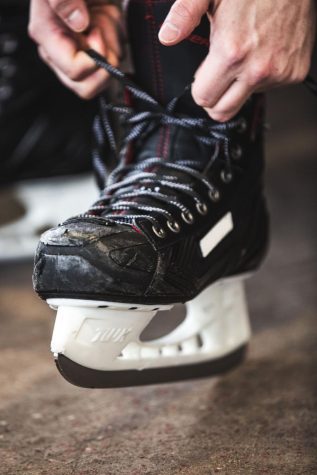A Whiff of Intolerance
Imagine entering a room. A pungent odor assaults you. The exact scent is unimportant. Perhaps a cigarette was just smoked. Or an adolescent applied too heavy a dose of Axe. Maybe a natural bodily function poisoned the air. Your friend exclaims, “Whew, what stinks?” In just a few minutes, though, you adapt, and the neurons slow their firing. Your still evolving brain seeks out new smells. The odor, however, remains and is remarked on by the next person entering in the room. It permeates the air you breathe, yet now you are blissfully unaware. It gets into your clothing, though, and after you leave the room, others notice you and comment on the foul odor. Only when you reenter the room, do you again experience the stink.
Several of our colleagues had a similar experience when travelling to the State Championship Boys Basketball game in Springfield. What should have simply been a celebration of the most successful boys’ basketball season in the school’s history was, instead, marred by a whiff of intolerance. As the game progressed, the enthusiastic Nashoba sideline erupted with the Chieftain chop as students simulated a Native American scalping a hapless victim. Friends from other districts reacted in shock, asking how they could teach in a district that allowed such cruel parodies of a Native culture. The stench of the failure of our district to confront the question of the Chieftain mascot and the practices and attitudes it encourages brought an awkward discomfort instead of a joyful celebration of the team’s success.







Denise Pollock • Jul 23, 2018 at 7:23 pm
I am thankful to see that there are educators and students who are aware of the unjust use of the “Chieftains” mascot at Nashoba Regional High School. As an ’07 graduate and indigenous student of Nashoba, I will add my voice to this discussion. My brother Mark Pollock and I, Denise Pollock, graduated from Nashoba within the last two decades. Both my brother and I played on sports teams at Nashoba and were forced to wear the Chieftain mascots. We just so happen to identify as Inupiaq and are tribal members of the federally recognized tribe, the Native Village of Shishmaref, located in Alaska.
As Inuit people, we have very different cultural and linguistic traditions from many federally recognized tribes in Massachusetts and throughout the United States. However, we have been colonized in a similar manner. I am deeply offended that the Nashoba Regional High School administration has continued to support the use and appropriation of the Chieftains mascot. Especially when students use offensive actions during sports games and on the field.
Nashoba provided my brother and me with a very limited and skewed history of indigenous peoples in the United States. I will say that Mr. Castner and my AP English teacher provided curriculum that taught some indigenous american history. Regardless, it appears that Nashoba does not educate its students on the history of indigenous peoples when its students act in a manner that continues the oppression of subjugation of indigenous peoples during sports events and elsewhere.
The use of the Chieftains mascot treats indigenous peoples as if they no longer exist today, when in fact, indigenous peoples are still here and we are thriving as a people. Perhaps, the administration might consider trading the Chieftain mascot for a “Caucasian” mascot since the majority of students and teachers are of Euroamerican descent. That seems to be more fitting and representative of the student body. What makes the leadership at Nashoba feel as though they have the right to appropriate a “race” or a “nation” of people that they know very little about? It is white privilege and U.S. colonization that enables the perpetuation of the use of the Chieftain mascot. What happened to the indigenous people of Massachusetts and the United States? The majority of them experienced genocide at the hands of Euroamerican colonizers. It seems odd that Euroamericans want to honor indigenous peoples through mascots. Let’s honor Masschusetts indigenous people by calling on the State of Massachusetts and the federal government to honor treaty rights and self-governance of the people who lived on this land before the arrival of illegal Euroamerican immigrants.
The Washington Redskins and the North Dakota Fighting Sioux are two American sports teams with “Indian” mascots that act as examples of how colonization and appropriation of indigenous peoples harms indigenous peoples physically, culturally, mentally, and spiritually today. It is harmful to me, my brother, other indigenous students and peoples to see the Chieftains mascot representing Nashoba. I do not think the Chieftain mascot honors the Wampanoag or Nipmuc people that still live in New England. I think it is incredibly disrespectful. It is embarrassing. If Nashoba prides itself as an institution that provides high quality education, then it must come to terms with history and justice. It must reconcile with white privilege and its colonial actions and apologize. If the administration fails to do this, then they are accepting their oppression of indigenous peoples and their indigenous students.
I believe that Nashoba is a great place to learn. I thoroughly enjoyed my time at Nashoba and I believe our educators are thoughtful and kind people. Nashoba helped me get a degree from the University of Massachusetts-Amherst. Nashoba is part of the reason that I was able to work in Washington DC for the Native American Contractors Association and the National Congress of American Indians for four years. Nashoba is part of the reason why I am able to serve 15 Alaska Native coastal communities on climate adaptation strategies as the Research Director at the Alaska Institute for Justice for the last 3 years. As an Inupiaq woman, it has been my greatest honor to protect the human rights and the self-determination of the indigenous peoples who have resided in the United States and Canada. My family and community survived epidemics, forced relocation, forced BIA educations, the loss of language and culture, but we are still here and we intend to live our lives with dignity.